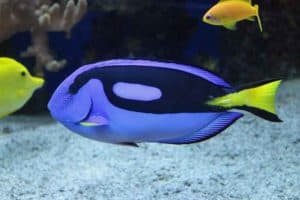


Spine-cheek Anemonefish (Premnas biaculeatus)are perhaps the most interesting to look at, with their ‘fluffy’ fins coming out of their faces, belly, back and tail. Apparently some examples of this species can lack the white stripe altogether, although we have never seen this ourselves.

Fins are generally light orange and the white stripe appears luminous against the black body. Clark’s Anemonefish (Amphiprion clarkii) grow to around 12cm long.īlack Anemonefish (Amphiprion melanopus)have a large white, vertical stripe separating their orange head from their black body. Its colouring is similar to the Clown Anemonefish, having an orange body, but with only two vertical white stripes bordered in black and a white tail. Growing up to 10cm long, Pink Anemonefish have a light pink/orange body, with a white stripe running down their back and either side of their face and white tail.Ĭlark’s Anemonefish(also known as the Great Barrier Reef Anemonefish) is another one we see quite a lot off Cairns. Pink Anemonefish (Amphiprion perideraion)are the ones we see most frequently, often living in the most magnificent sea anemone homes. Strangely, these are the Anemonefish you are least likely to see when visiting Cairns’ Great Barrier Reef, we’re not sure if it’s due to their popularity with aquarium owners, or just general distribution. These little orange fish have three white vertical bands, bordered in black, and grow to around 11cm (4.3 inches). With their distinctive and unique colouring, each of these Anemonefish is delightful to watch as they dart in and out of their sea anemone homes.Ĭlown Anemonefish (Amphiprion percula) are definitely the most recognisable, thanks to Nemo. In our travels we frequently come across five different types of Anemonefish: Clown, Pink, Clark’s, Black and Spine-cheek Anemonefish. We have spent many days and dives exploring Cairns’ Great Barrier Reef and the northern Ribbon Reefs. Juvenile Anemonefish are adorable and move very fast! In fact, just one day after hatching, these cute little critters can move 9.5 body lengths per second – making them faster than most Olympic swimmers! If you are lucky enough to see one, you will be mesmerised by its beauty and speed. In turn, a smaller male will become the dominant male of the sea anemone home.Īnemonefish eggs are laid in or near the anemone, and tended by the adults. If the female in the colony dies, then the dominant male becomes the female. This is known as Protandrous Hermaphroditism. Interestingly, Anemonefish are one of the few fish species that hatches as a male, but can turn itself into a female if circumstances require. All Anemonefish communities are dominated by a large female, who shares her home with smaller males.

Sea anemones vary in size, as does the population of Anemonefish that may inhabit them, growing anywhere from one pair to several fish. These soft bodied organisms have stinging cells in their tentacles, similar to the tentacles of a Jellyfish, which the Anemonefish protect themselves from with a mucus body covering. Sea anemones require sunlight for photosynthesis and for this reason, they are generally found in clear, shallow waters. All Anemonefish share one common trait, they live in sea anemones.


 0 kommentar(er)
0 kommentar(er)
